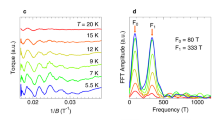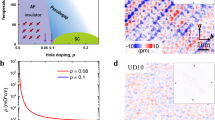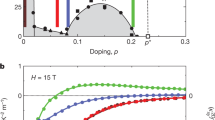Abstract
High-temperature (high-Tc) superconductivity in cuprates arises from carrier doping of an antiferromagnetic Mott insulator. This carrier doping leads to the formation of electronic liquid-crystal phases1. The insulating charge-stripe crystal phase is predicted to form when a small density of holes is doped into the charge-transfer insulator state1,2,3, but this phase is yet to be observed experimentally. Here, we use surface annealing to extend the accessible doping range in Bi-based cuprates and realize the lightly doped charge-transfer insulating state of the cuprate Bi2Sr2CaCu2O8+x. In this insulating state with a charge transfer gap on the order of ~1 eV, our spectroscopic imaging scanning tunnelling microscopy measurements provide strong evidence for a unidirectional charge-stripe order with a commensurate 4a0 period along the Cu–O–Cu bond. Notably, this insulating charge-stripe crystal phase develops before the onset of the pseudogap and formation of the Fermi surface. Our work provides fresh insight into the microscopic origin of electronic inhomogeneity in high-Tc cuprates.
This is a preview of subscription content, access via your institution
Access options
Access Nature and 54 other Nature Portfolio journals
Get Nature+, our best-value online-access subscription
$29.99 / 30 days
cancel any time
Subscribe to this journal
Receive 12 print issues and online access
$259.00 per year
only $21.58 per issue
Buy this article
- Purchase on Springer Link
- Instant access to full article PDF
Prices may be subject to local taxes which are calculated during checkout



Similar content being viewed by others
Data availability
The data supporting the findings of this study are available upon request from the corresponding author.
References
Kivelson, S. A., Fradkin, E. & Emery, V. J. Electronic liquid-crystal phases of a doped Mott insulator. Nature 393, 550–553 (1998).
Zaanen, J. & Gunnarsson, O. Charged magnetic domain lines and the magnetism of high-T c oxides. Phys. Rev. B 40, 7391–7394 (1989).
Löw, U., Emery, V. J., Fabricius, K. & Kivelson, S. A. Study of an Ising model with competing long- and short-range interactions. Phys. Rev. Lett. 72, 1918–1921 (1994).
Kivelson, S. A. et al. How to detect fluctuating stripes in the high-temperature superconductors. Rev. Mod. Phys. 75, 1201–1241 (2003).
Tranquada, J. M., Sternlieb, B. J., Axe, J. D., Nakamura, Y. & Uchida, S. Evidence for stripe correlations of spins and holes in copper oxide superconductors. Nature 375, 561–563 (1995).
Wu, T. et al. Magnetic-field-induced charge-stripe order in the high-temperature superconductor YBa2Cu3Oy. Nature 477, 191–194 (2011).
Abbamonte, P. et al. Spatially modulated ‘Mottness’ in La2-xBaxCuO4. Nat. Phys. 1, 155–158 (2005).
Ghiringhelli, G. et al. Long-range incommensurate charge fluctuations in (Y,Nd)Ba2Cu3O6+x. Science 337, 821–825 (2012).
Comin, R. et al. Broken translational and rotational symmetry via charge stripe order in underdoped YBa2Cu3O6+y. Science 347, 1335–1339 (2015).
Howald, C., Eisaki, H., Kaneko, N. & Kapitulnik, A. Coexistence of periodic modulation of quasiparticle states and superconductivity in Bi2Sr2CaCu2O8+δ. Proc. Natl Acad. Sci. USA 100, 9705–9709 (2003).
Vershinin, M. et al. Local ordering in the pseudogap state of the high-T c superconductor Bi2Sr2CaCu2O8+δ. Science 303, 1995–1998 (2004).
Comin, R. et al. Charge order driven by Fermi-arc instability in Bi2Sr2−xLaxCuO6+δ. Science 343, 390–392 (2014).
Cai, P. et al. Visualizing the evolution from the Mott insulator to a charge-ordered insulator in lightly doped cuprates. Nat. Phys. 12, 1047–1051 (2016).
Mesaros, A. et al. Commensurate 4a 0-period charge density modulations throughout the Bi2Sr2CaCu2O8+x pseudogap regime. Proc. Natl Acad. Sci. USA 113, 12661–12666 (2016).
Lawler, M. J. et al. Intra-unit-cell electronic nematicity of the high-T c copper-oxide pseudogap states. Nature 466, 347–351 (2010).
Wise, W. D. et al. Charge-density-wave origin of cuprate checkerboard visualized by scanning tunnelling microscopy. Nat. Phys. 4, 696–699 (2008).
Hanaguri, T. et al. A ‘checkerboard’ electronic crystal state in lightly hole-doped Ca2-xNaxCuO2Cl2. Nature 430, 1001–1005 (2004).
Kohsaka, Y. et al. An intrinsic bond-centered electronic glass with unidirectional domains in underdoped cuprates. Science 315, 1380–1385 (2007).
Kohsaka, Y. et al. How Cooper pairs vanish approaching the Mott insulator in Bi2Sr2CaCu2O8+δ. Nature 454, 1072–1078 (2008).
Parker, C. V. et al. Fluctuating stripes at the onset of the pseudogap in the high-T c superconductor Bi2Sr2CaCu2O8+x. Nature 468, 677–680 (2010).
Kohsaka, Y. et al. Visualization of the emergence of the pseudogap state and the evolution to superconductivity in a lightly hole-doped Mott insulator. Nat. Phys. 8, 534–538 (2012).
Fujita, K. et al. Simultaneous transitions in cuprate momentum-space topology and electronic symmetry breaking. Science 344, 612–616 (2014).
da Silva Neto, E. H. et al. Ubiquitous interplay between charge ordering and high-temperature superconductivity in cuprates. Science 343, 393–396 (2014).
Ruan, W. et al. Relationship between the parent charge transfer gap and maximum transition temperature in cuprates. Sci. Bull. 61, 1826–1832 (2016).
Pan, S.-H. et al. Microscopic electronic inhomogeneity in the high-T c superconductor Bi2Sr2CaCu2O8+x. Nature 413, 282–285 (2001).
Lang, K. M. et al. Imaging the granular structure of high-T c superconductivity in underdoped Bi2Sr2CaCu2O8+δ. Nature 415, 412–416 (2002).
McElroy, K. et al. Atomic-scale sources and mechanism of nanoscale electronic disorder in Bi2Sr2CaCu2O8+δ. Science 309, 1048–1052 (2005).
Zeljkovic, I. et al. Imaging the impact of single oxygen atoms on superconducting Bi2+ySr2-yCaCu2O8+x. Science 337, 320–323 (2012).
Zhou, S., Ding, H. & Wang, Z. Correlating off-stoichiometric doping and nanoscale electronic inhomogeneity in the high-T c superconductor Bi2Sr2CaCu2O8+δ. Phys. Rev. Lett. 98, 076401 (2007).
Mitzi, D. B., Lombardo, L. W., Kapitulnik, A., Laderman, S. S. & Jacowitz, R. D. Growth and properties of oxygen- and ion-doped Bi2Sr2CaCu2O8+δ single crystals. Phys. Rev. B 41, 6564–6574 (1990).
Fradkin, E., Kivelson, S. A. & Tranquada, J. M. Colloquium: Theory of intertwined orders in high temperature superconductors. Rev. Mod. Phys. 87, 457–482 (2015).
Wang, Y. & Chubukov, A. V. Interplay between unidirectional and bidirectional charge-density-wave orders in underdoped cuprates. Phys. Rev. B 92, 245140 (2015).
Arrigoni, E., Fradkin, E. & Kivelson, S. A. Mechanism of high-temperature superconductivity in a striped Hubbard model. Phys. Rev. B 69, 214519 (2004).
Huang, E. W. et al. Numerical evidence of fluctuating stripes in the normal state of high-T c cuprate superconductors. Science 358, 1161–1164 (2017).
Tranquada, J. M., Buttrey, D. J., Sachan, V. & Lorenzo, J. E. Simultaneous ordering of holes and spins in La2NiO4.125. Phys. Rev. Lett. 73, 1003–1006 (1994).
Comin, R. & Damascelli, A. Resonant X-ray scattering studies of charge order in cuprates. Annu. Rev. Condens. Matter Phys. 7, 369–405 (2016).
Acknowledgements
The authors thank M. Allan, J.C. Davis, J.E. Hoffman, S. Kivelson and S. Sachdev for insightful conversations. I.Z. acknowledges support from DARPA grant no. N66001-17-1-4051 (Z.R.), Army Research Office grant no. W911NF-17-1-0399 (B.R.), National Science Foundation grant no. NSF-DMR-1654041 (H.Z.) and the Boston College startup. Z.W. acknowledges support from the US Department of Energy, Basic Energy Sciences grant no. DE-FG02-99ER45747. The work in Brookhaven was supported by the Office of Science, US Department of Energy under contract no. DE-SC0012704. J.S. and R.Z. were supported by the Center for Emergent Superconductivity, an Energy Frontier Research Center funded by the US Department of Energy, Office of Science.
Author information
Authors and Affiliations
Contributions
STM experiments were carried out by H.Z. Magnetization measurements were performed by Z.R. Temperature-dependent reflection high-energy electron diffraction measurements and heater calibration were carried out by B.R. Single crystals of optimally doped Bi-2212 were obtained from J.S., R.Z. and G.G. H.Z. analysed the STM data with guidance from I.Z. I.Z. designed and supervised the project. Z.W. provided theoretical input on the interpretation of STM data. I.Z. and Z.W. wrote the manuscript with input from all the authors.
Corresponding author
Ethics declarations
Competing interests
The authors declare no competing interests.
Additional information
Publisher’s note: Springer Nature remains neutral with regard to jurisdictional claims in published maps and institutional affiliations.
Supplementary information
Supplementary Information
Supplementary Sections 1–8, Supplementary Figures 1–11, Supplementary References 1–16
Rights and permissions
About this article
Cite this article
Zhao, H., Ren, Z., Rachmilowitz, B. et al. Charge-stripe crystal phase in an insulating cuprate. Nature Mater 18, 103–107 (2019). https://doi.org/10.1038/s41563-018-0243-x
Received:
Accepted:
Published:
Issue Date:
DOI: https://doi.org/10.1038/s41563-018-0243-x
This article is cited by
-
Unified energy law for fluctuating density wave orders in cuprate pseudogap phase
Communications Physics (2022)
-
Quantum phase transition from superconducting to insulating-like state in a pressurized cuprate superconductor
Nature Physics (2022)
-
Visualization of rotational symmetry breaking electronic states in MnBi2Te4 and MnBi4Te7
Quantum Frontiers (2022)
-
Charge order textures induced by non-linear couplings in a half-doped manganite
Nature Communications (2021)
-
Locally commensurate charge-density wave with three-unit-cell periodicity in YBa2Cu3Oy
Nature Communications (2021)



